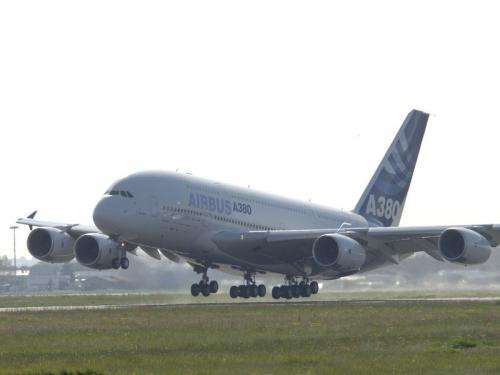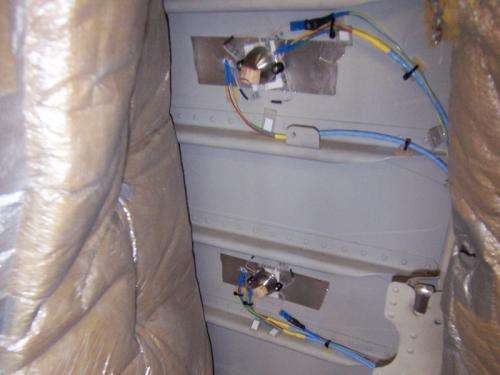Will planes soon take of with energy harvesters on board?
An idea from EADS and Vienna University of Technology is taking off: in a joint project, Energy Harvester Modules suitable for aircrafts have been tested, which should supply sensor nodes with electrical power in the future.
Like a nervous system in a human body, sensor networks attached to the aircraft fuselage will in future record and transmit essential data concerning the structural health of the aircraft. Traditionally, wired sensor solutions are used, which are reliable, but introduce weight and increase the design complexity of an aircraft. To solve this challenging task EADS Innovation Works and Vienna University of Technology are in a close cooperation in developing a thermoelectric "Energy Harvesting Module" with just a few centimetres in outer diameter, which will supply enough energy to wireless sensor nodes. The artificial temperature difference created when the aircraft takes off and lands is sufficient to generate the required electrical energy. A flight test campaign on an Airbus aircraft with these "Energy Harvesting Modules" has been performed for the first time – with extraordinary success.
Cost factor: Aircraft maintenance
Maintenance is one of the largest expenses along with air crew salaries, fuel costs and depreciation a civil aviation company has to incur over the lifetime of an aircraft and can be as high as 20% of its total cost. The autonomous wireless sensor nodes will monitor the health status of an aircraft and wirelessly transmit the data to the maintenance system of the aircraft.
The Energy-Harvester-Module.
"Such a system obviously has major advantages, however, the main problem lies in the energy supply", says Prof. Ulrich Schmid from the Institute of Sensor and Actuator Systems at Vienna University of Technology. "Conventional batteries are not designed for such large temperature difference to which an aircraft is continuously exposed during operation. In addition, nobody wants to regularly replace all the sensor batteries in the complete aircraft. Using conventional cabling, on the other hand, would significantly increase the weight of the aircraft." Together with EADS Innovation Works, Prof. Schmid has developed an approach to harvest electrical energy for the sensor nodes directly from the temperature changes present at fuselage of an aircraft during operation.
Energy from temperature differences
When two different electrically conductive materials are joined and their contact points have different temperatures, an electrical voltage is generated. This phenomenon is known as the "Seebeck effect". The outer hull of an aircraft undergoes a massive temperature change during take-off and landing, so that temperature differences occur on the fuselage. "We can make optimal use of these temperature gradients by attaching a small thermal mass to one side of the thermoelectric generator", explains Alexandros Elefsiniotis, one of Prof. Schmid's PhD students. "A water reservoir of about ten cubic centimetres freezes during take-off. It cools down at a slower rate than the fuselage, thus a thermoelectric generator located between these components creates electricity from that temperature difference." Inversely, during landing procedure, the fuselage temperature of the aircraft is warmer than that of the water reservoir and hence, energy is again generated. A tailored low-power management system ensures that the voltage output strongly varying in time is converted into constant and appropriate voltage levels, which can drive a sensor node most efficiently.
Successful tests at EADS
The start of the project involved simulations and climate chamber experiments. Based on these promising results, EADS Innovation Works has recently carried out the first test flights with Energy Harvesting Modules on an Airbus aircraft. Alexandros Elefsiniotis states: "We have been able to obtain around 23 joules of energy per flight, which is sufficient to power up a wireless sensor node." Depending on the outside temperature, it is possible that alternative materials other than water could be more suitable – research is currently ongoing into appropriate strategies for extreme situations, for example for flight routes in very cold regions."EADS Innovation Works wants to use the best available technology for the autonomous sensors in future, therefore the new method is of great interest to us", explains Prof. Becker from EADS Innovation Works. "We are confident that energy autonomous sensors will soon be flying in our aircrafts."
Provided by Vienna University of Technology

























